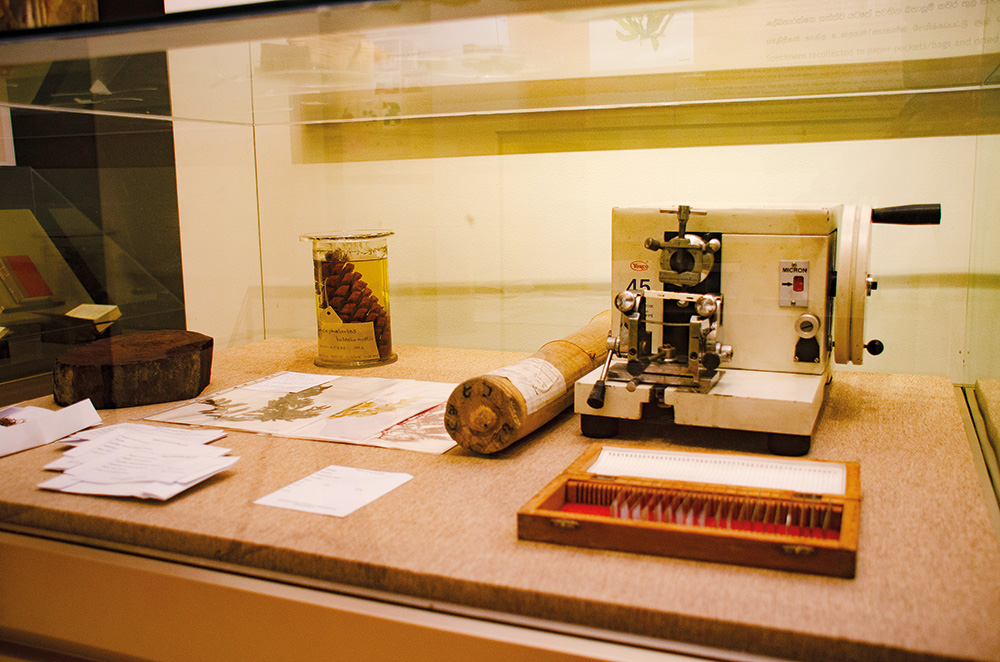Today…Pera opens Alexander Moon Commemorative Museum
A Royal Garden with a Global Story
On a lush bend of the Mahaweli, just outside Kandy, lie 147 acres of living history. The Royal Botanic Gardens of Peradeniya are no mere park; they are a chronicle of Sri Lanka’s evolving relationship with nature – a living encyclopaedia of trees, orchids, spices and stories.
Their origins stretch back to the 14th century, when King Vikramabahu III established the site as a royal garden. Under Keerthi Sri Rajasinghe, it became a pleasure ground where monarchs and monks strolled under the shade of rare trees. After the British takeover in 1815, it was transformed into a testing ground for coffee, cinnamon and other lucrative crops while also becoming a centre of scientific learning.
“Peradeniya was never just about beauty,” says Dr. Ravindra Kariyawasam, Environmental Advisor to the Ministry of Environment. “It has always been about knowledge, about linking people to the ecosystems around them.”
By the mid-1800s, Peradeniya was being modelled on Kew Gardens in England. Dr. G.H. Thwaites and Henry Thumann introduced new species, spearheaded experiments and oversaw the arrival of rubber. By the turn of the 20th century it was both a showpiece and a laboratory.
A Garden of Thousands
Today the gardens boast over 4,000 plant species, including:
300 types of orchids in a dedicated house
Medicinal gardens and spice collections – cinnamon, pepper, cardamom
Exotic giants such as the Double Coconut Palm, Cannonball Tree, Giant Bamboo of Burma, and Ceylon Ironwood
Every year, about two million visitors pass through its gates, making Peradeniya Sri Lanka’s largest and most beloved botanic garden. Schoolchildren sit sketching by the Bo Tree while wedding photographers capture couples under the towering Javan fig.
Alexander Moon’s Legacy Revived
Today, 28 September 2025, a new chapter will begin when Peradeniya opens the Alexander Moon Commemorative Museum. Moon was the first to publish a comprehensive catalogue of Sri Lanka’s endemic plants in 1824, laying the foundation for the island’s botanical science.
The new museum’s purpose is bold: to conserve endangered species, safeguard genetic material, promote cutting-edge research and share environmental knowledge with the public, especially the next generation.
“This is far more than a display of dried plants or pretty specimens,” explains Dr. Kariyawasam. “It’s an initiative to turn our botanical heritage into a living classroom – a place where people can understand the ecosystems these plants support, the threats they face, and the steps we can take to protect them. We are linking tradition with science, conservation with community.”
A Museum with a Mission
Inside the Moon Museum, visitors will find:
Interactive displays explaining ecosystems and plant evolution
Dry-plant indicators and models showing plant history
Guidance on local conservation initiatives (“incitive conservation”)
Exhibits on how plants support habitats and communities
It is Sri Lanka’s answer to global leaders like the New York Botanical Garden Museum, Missouri Botanical Garden, Singapore’s UNESCO-listed Botanic Gardens, and Edinburgh’s Royal Botanic Garden – where gardens are tied to university systems and serve as research hubs for biodiversity.
Learning from the World
Botanical museums are not a new idea. From the ancient monastic gardens of the Christian world to Baghdad’s Islamic Golden Age, from Mohenjo-Daro to the Nile valley, societies have maintained living libraries of plants. In Europe, Padua established its Orto Botanico in 1545; Pisa followed in 1544; Florence in 1546; the Netherlands in 1593. By 1759, Kew Gardens had become the global model.
Peradeniya’s Moon Museum draws on this lineage. It will combine local knowledge with global best practice, bringing Sri Lanka into the same conversation as the great botanic institutions of the world.
Why It Matters Now
Sri Lanka’s biodiversity is under pressure from deforestation, climate change and urbanisation. Plants once common in the highlands now cling to survival in fragmented patches of forest. Seeds and genetic material are disappearing before they can be studied.
Speaking to The Sunday Island, Dr. Kariyawasam said:”In an era of climate change and rapid urbanisation, preserving and sharing our plant knowledge is no longer optional,” stresses Dr. Kariyawasam. “It’s essential for our survival.”
By honouring a pioneering botanist while creating a forward-looking platform for conservation, Peradeniya is poised to become a model for how heritage sites can tackle modern environmental challenges. The Moon Museum’s outreach to schools and communities will make plant science accessible to children who might never otherwise see a double coconut palm or understand how an orchid pollinates.
A Place for People as Well as Plants
The new museum is designed not as a hushed hall but as a dynamic space:
Touch-screen kiosks where students can explore plant genomes
Walk-through dioramas of ecosystems from dry-zone scrub to montane cloud forest
Seed banks and herbarium samples showing how scientists conserve genetic material
Story-boards on Sri Lanka’s spice history and its links to global trade
This people-centred approach reflects a global trend in botanical institutions. “Conservation only works if people understand why it matters,” Dr. Kariyawasam notes. “By making science tangible, we create the next generation of custodians.”
Beyond the Gates
Peradeniya has long been more than a collection of plants. During the Second World War, Allied Commander Lord Louis Mountbatten used it as a base for South-East Asian operations. Today its avenues have names – Palm Avenue, Great Lawn – that echo a colonial past even as they host modern scientific work.
The Moon Museum extends that outward focus. Partnerships are planned with universities, local councils and community groups. Exhibitions will travel to schools. Training workshops for teachers will help integrate plant science into curricula.
A Green Legacy for Generations
From the first royal sapling to the latest interactive exhibit, Peradeniya has evolved without losing its soul. The Moon Museum promises to deepen that legacy – turning the garden from a place of passive wonder into a dynamic space of learning, research and action.
As visitors wander past the Giant Javan Fig Tree, past orchids collected by kings and botanists alike, they will now also step into a museum that tells the story of Sri Lanka’s plants – and, by extension, its people.
“Peradeniya’s plants are living history,” says Dr. Kariyawasam. “The museum will ensure they also become living teachers.”
By Ifham Nizam 








